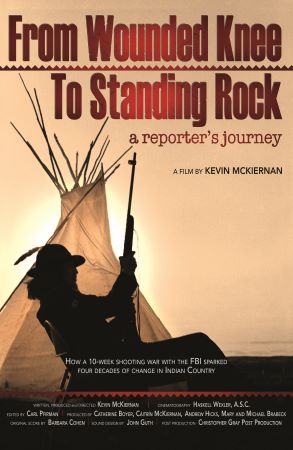
From Wounded Knee to Standing Rock: A Reporter's Journey 2022
Distributed by The Video Project, 145 - 9th St., Suite 230, San Francisco, CA 94103; 800-475-2638
Produced by Kevin McKiernan
Directed by Kevin McKiernan
Streaming, 88 mins
High School - General Adult
Journalism; Native American; Social Movements
Date Entered: 11/07/2023
Reviewed by Joseph Baumstarck, Jr., Adjunct Professor - Ivy Tech Community College and Independent ScholarFrom Wounded Knee to Standing Rock is a must-see documentary film regarding one of the most important events in modern Native American consciousness. Not only does Wounded Knee and its aftermath affect today's Native Americans, but it has had a widespread impact on many areas of American culture, including law, politics, media relations, activism, and activist organizations. It is several stories wrapped into one film.
On one level, it is the story of a young reporter on his first assignment. Kevin McKiernan is offered the opportunity to go to Wounded Knee, South Dakota, on the Lakota Indian Reservation and document events there as the American Indian Movement's (AIM) armed uprising unfolds. As a rookie reporter, McKiernan makes some seasoned professional decisions that would have long-lasting consequences for America's understanding of this event and his life. Essentially infiltrating Wounded Knee through a government-established blockade, he befriends and gains the trust of several Wounded Knee residents and AIM activists. This gains him unprecedented and, in large part, the only media access to the internal workings of the uprising. It also leaves him with many unanswered questions that haunt him. Eventually, it results in his reestablishing contact with a Native American he filmed during this time who now lives in California. The two discuss their observations after almost fifty years of reflection. This story alone makes this film worthwhile.
A second more macabre story continues to appear inconveniently and, as in real life, has no satisfactory conclusion in this film. It involves the suspicious death of a young Native American woman who, during the uprising, becomes an acquaintance and confidante of McKiernan. Her suspicious death, possibly at the hands of AIM leaders, lends a twist to this film that shows the multi-faceted nature of the whole AIM activist system and the government's response to it. It further shows the callous nature with which young Native American women's deaths were and are treated on Indian Reservations. This situation has not improved and continues to fester on Reservations today.
A third story highlights Native American life on a reservation during a time when few Americans knew what this life entailed. In brutally honest footage, McKiernan shows the living conditions as they existed in Wounded Knee in 1973 and gives some sense of the changes, and lack thereof, that occurred during the government blockade of the reservation during this standoff. This is compared poignantly with modern-day conditions on Indian Reservations in other areas today. Interestingly, there is less difference between conditions in Wounded Knee in 1973 and on reservations today than most people would expect.
In this film, no one, including McKiernan, escapes intact or unsullied. This film shows the pettiness of all actors. It lets the audience see how these character flaws impacted the drama of the standoff and the everyday lives of people, especially Native Americans on the reservations. McKiernan spends the last part of the film trying to establish a path between Wounded Knee and other Native American issues, including the Standing Rock Pipeline. His premise is that the Pan-Native American identity that he believes was established among Native Americans of different groups and different reservations has solidified into a unity that he sees reflected in the Standing Rock Pipeline protests. This is a definite stretch, and he lacks the evidence for such an assertion. Many other assessments of Native American unity versus tribalism or reservation identity come to different conclusions.
Overall, this is a well-done documentary film that leaves the viewer with much to think about and, if nothing else, broadens the viewer's understanding of America's Native American issues. This film is rated Highly Recommended and should be made widely available. It has potential in high school through graduate school classrooms, discussion groups, and almost any library. College-level courses in journalism, activism, social movements, Native American studies, politics, law enforcement, violence, and peace studies would all benefit from this film.
Published and licensed under the Creative Commons Attribution 4.0 license. Anyone can use these reviews, so long as they comply with the terms of the license.